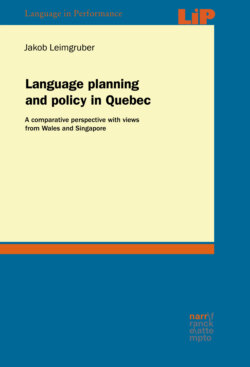Читать книгу Language planning and policy in Quebec - Jakob Leimgruber - Страница 6
На сайте Литреса книга снята с продажи.
List of Figures
ОглавлениеFigure 1.1: Historic French provinces (Charbonneau and Guillemette, 1994, 164).
Figure 2.1: A map of Canada showing Quebec.
Figure 2.2: Poster advertising emigration to Canada in Swedish (from Gagnon, 2016). The orthography used places the poster before the spelling reform of 1906.
Figure 2.3: Proportion (percent) of Aboriginal population by language use (National Household Survey 2011).
Figure 3.1: The Integrative framework proposed by Hornberger (2006, 29): language planning and policy types are in regular typeface, approaches in italics, and goals in bold; Hornberger’s own comments are in those in (parentheses). The four elements of the matrix by Haugen (1983) are headed by double-underlined small-capital headings added by Hornberger.
Figure 4.1: Locations of the 1 101 signs photographed. Note the clear bias towards Greater Montreal, as well as the relative sparsity of data from other parts of the province.
Figure 4.2: Four kinds of stops sign found in the province. Top left: standard arrêt sign, Mile-End; top right: stop sign, Kahnawà:ke; bottom left: stop/testan sign, Kahnawà:ke; bottom right: arrêt/stop sign, Roxboro.
Figure 5.1: Self-declared proficiency in the ‘other’ language.
Figure 5.2: Self-declared proficiency in the ‘other’ language, by speech community and age group.
Figure 5.3: Age-grading in agreement levels to the statement ‘Bill 101 was necessary’.
Increasing disagreement to the left of the scale, increasing agreement to the right; neutral responses in the centre.
Figure 5.4: Correlation between average self-declared proficiencies in the ‘other’ language and agreement levels with the statement ‘I think carefully about which language to use when first speaking to someone I don’t know’. Francophones: R_{adj}^{2} = 0.05368, p = 0.001462, Anglophones: R_{adj}^{2} = 0.03646, p = 0.0001961.
Figure 5.5: Age-grading across speech communities in agreement levels to the statement ‘Bill 101 was necessary’.
Figure 5.6: Geolocation of the signs collected in the Montreal metropolitan region.
Figure 5.7: Percentage of speakers who have French as their first official language spoken, province of Quebec.
Figure 5.8: Percentage of speakers declaring English as their only mother tongue, Montreal Census Metropolitan Area.
Figure 5.9: Percentage of speakers declaring a language other than French or English as their home language, Montreal Census Metropolitan Area.
Figure 5.10: Signs inside an AMT carriage on the Vaudreuil line. The electronic information panel displays the next station (in French only). The poster admonishing passengers to give up their seats to persons in need is in French only, too. The sign displaying information on how to carry out an emergency call is bilingual, with French slightly larger than the English version and placed above it.
Figure 5.11: Example of a semi-matched advertising billboard (from Vingron et al. 2018).
Figure 5.12: Fixations over time, by L1, for the set of ‘naturalistic’ signs from Montreal’s linguistic landscape. The horizontal axis shows the 8-second viewing period. Note, in particular, the fixations on French and English in the category ‘bilingual signs’.
Figure 6.1: Comparison through the interactive policy process (Figure 1.2 in Morris 2010, 13).
Figure 6.2: By principal area.
Figure 6.3: By electoral ward.
Figure 6.4: Geographical proportional distribution of Welsh speakers (percentages). Data from the 2011 census, images from Commissioner (2015, 9–10).
Figure 6.5: Percentage of population with knowledge of Welsh, by age group, for the past seven censuses.
Figure 6.6: Language most commonly spoken at home, as a percentage of all households. Data from 10-year census (1980–2010) and from the General Household Survey 2015. ‘Dialects’ refers to any variety of Chinese other than Mandarin.
Figure 7.1: Evolution of net migration for the province of Quebec, showing both international and interprovincial migration, overlaid with the total net migration figure.
